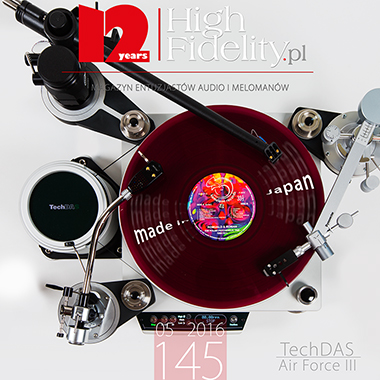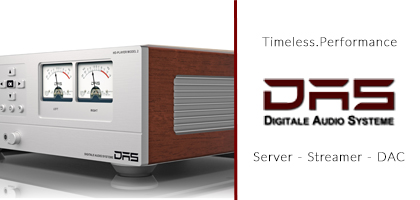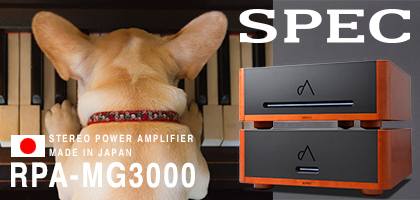No. 257 October 2025
- COVER REVIEW: ANCIENT AUDIO Silver Grand Mono Mk II ⸜ power amplifier • monoblocks » POLAND • Kraków
- KRAKOW SONIC SOCIETY № 153: 30 years of ANCIENT AUDIO » POLAND • Kraków
- FEATURE ⸜ music & technology: HISAO NATSUME presents - In search for the lost great pianism Chopin tradition » part 2 (France) » JAPAN • Tokyo
- REVIEW: AUDIOPHONIQUE Classic AP 300D ⸜ power amplifier » POLAND • Pruszków
- REVIEW: AVATAR AUDIO Holophony No. 1 ⸜ loudspeakers • floor-standing » POLAND • Osowicze
- REVIEW: DIVALDI Gold PA One ⸜ integrated amplifier » POLAND • Kraków
- REVIEW: J.SIKORA Aspire ⸜ turntable (deck + tonearm) » POLAND • Lublin
- REVIEW: MB AUDIO CABLE Silver ⸜ analog interconnect ⸜ RCA » POLAND • Turza Śląska
- REVIEW: XACT N1 ⸜ LAN switch » POLAND • Wrocław


|

|
|
„COLLECTOR’S EDITION” 
Queen: The Studio Collection. Special Edition Vinyl Box
With this stage, so at least it seems, ends the almost Copernican revolution, ie. 'deliverance' from medium and format (not really, but let's say so). However, while that revolution was summarized Galileo by famous: “Eppur a muove” ("and yet it moves"), the new revolution, apparently, is about stopping a spinning silver disc and prove the opposite thesis ("Eppur non si muove"). For some time still some discs will spin in computer hard drives, but at some point SSD discs will take completely over. 
Kylie Minogue: Let's Get To It: Collector's Edition The transition from physical form to a digital representation of a product - we are talking primarily about the sound, image and printing - have been accelerated by changes in customers' shopping habits. As reported once by "The Independent" magazine between 1998 and 2009 a number of independent record shops in the UK has decreased from 1,064 to just 269, which in his, quite a tasteful way, Graham Jones portrayed in his 2012 Last Shop Standing film. In other countries with less well-established traditions, eg. in Poland, the process was even more rapid and unambiguous. And yet ... I do not know if you noticed a small, yet noticeable the last few years swing in the opposite direction, noticeable from the moment in which it seemed that for physicality, tangibility, "organoleptic" were already pushed into a corner where they were supposed to finally die. As in the introduction to the wonderful issued volume, Collector's Edition. Innovative Packaging and Graphics (Thames & Hudson, London, 2014), devoted to special collector's editions of CDs, books and magazines, Stuart Tolley writes, there are few reasons of this situation. In case of the vinyl records, he says, events such as Record Store Day, books and magazines, on the other hand, were supported by a lot of independent publishers, who were able to attracted entirely new audience. 
„TONEAudio” – the first printed issue of a web-based magazine The traditional development model has once again become attractive. Again "printed" means "better"; printed magazine has increased the importance of the species and is more reliable than the Internet. This is a simplification, I know this, because I worked in both types of magazines, eventually betting on the Internet. But there is still something inside me that truly values paper. It's no coincidence that every year at the Audio Show (now Audio Video Show) we give visitors the printed version of the test taken from the current issue of "High Fidelity", with a cover, table of contents, and so on. This is why Jeff Dorgay, chief editor of the American magazine "TONEAudio" decided to transcribe fundraising for a printed issue of his magazine. Its copy recently arrived (see an interview with Jeff HERE). A decisive factor, which restored the physical releases on sales map, however, were - according to Tolley - "collector's edition". They are the ultimate, ie. the best possible way to connect the artist and the audience (we are talking about a serial products, meaning made in more than one copy). In music, it can be seen especially clearly from the moment at which the streaming assumed the role of leading the way to listen to music. While earlier music lovers still were under impression that by buying a music file they acquired something real, streaming deprived them of even such a substitute of property; now they can only connect to the stream, but without extracting anything from it. 
„TONEAudio” – if the magazine had been issued on paper on regular bases it would have been the most beautiful printed audio magazine in the world I do not want to be misunderstood - it is good that such changes occur. Thanks to them more people listen to the music than ever before, and many of them sooner or later ask for a better quality. It's the ultimate democratization and equalization of art, launched with the print first, then carried on with audio and video recording. The point is that art with its dissemination is becoming shallower, less meaningful. And again - I'm not complaining, I just want to say that I'm not interested in such averaging, and thus, as I am not alone in this choice, I can anchor in the niche of physicality and 'consume' culture from there. Me mentioning physicality is no coincidence. When testing audio components I experience it every day - ultimately the music I listen to comes to me through them (devices, systems), they are part of the act of my exposure to the music. Audio thus becomes part of the artistic event. The so-called. "Black box", promoted in the 1970s and 1980s, as a reaction to the overloaded with functions, and thus poorly sounding devices made by large corporations, still has its supporters, and it is one of the few sensible ways of development. I, however, feel much closer to what the Japanese propose. 

On-wall, minimalist CD Player, designed by Naoto Fukasawa for Muji |
Today, the term "Made in Japan", apart from obvious indication of the country of origin of the product, also has other, deeper connotations. It probably won't be an exaggeration if I say that it is synonymous with the highest quality product. "Made in Japan" means that it has been well manufactured, in line with the work ethos, which for us Europeans, is almost mythical. A country that emerged from World War II, defeated and broken, as a result of forced political and economic reforms, thanks to import Western technology and management methods has become one of the largest economies in the world - this small island nation, almost completely devoid of natural resources, is now the third - after the US and China - national economy in the world, eg. They became a leader in car production already in 1980. Improving the quality of mass production succeeded only there. Though not always the phrase "Made in Japan" was synonymous with high quality, it is sufficient to recall the 1950s, when they were seen just as today the Chinese product are, however, its development, especially in the years 1954-1971, is still studied, discussed around the world and many try to repeat it. For now, without success. 
Mac Funamizu designed this unique CD Player, called Quackie It seems that high-quality industrial production was influenced by a specific bond, connecting Japanese with objects, expressed by the artistry of the local crafts. As Dominik Lisik wrote in the article Where things are true, the base for the birth, closely associated with the production of contemporary Japanese design, was created by a local crafts. And next he adds: Zen philosophy had a great influence on the aesthetics of utilitarian objects. Rejection of all ostentation, pomp and striving to achieve artistic effects by using very modest means characterized most of the traditional household appliances. A collection of Zen aesthetic ideal is perfectly represented by the famous Buddhist doctrine of wabi-sabi, which chadogu are the physical manifestation of - utensils used in the tea ceremony. [...] Minimalism of the handmade objects expresses respect for the natural properties of materials, it is not a about simplification, but bringing aesthetics to emphasize the essence of things. Have you ever felt a kind of harmony when looking at the device, as if all the elements were in place? I occasionally feel something like that. Not only when starring at some Japanese products, to be clear. The role of the companies from Germany, Switzerland and Scandinavia should also be emphasized, because they often match the solidity of the Japanese engineering and mature way of thinking about the design. Have a look at released last year by the publisher Thames & Hudson, album The Art of Impossible. The Bang & Olufsen Story , and you will see that some of the ideas associated with craftsmanship's reliability, with understanding the relationship between forms and content, do not have a nationality, they are transnational. But the point is that B & O is one of the exceptions, and in Japan the order of work, which, with all the technological sophistication is focused on the craft, on manually performed labor, seems only natural. 
Alastair Philip Whipher, The Art of Impossible. The Bang & Olufsen Story, London 2015 It is no coincidence that the CDs issued in Japan are almost always much better than their western counterparts - this is about quality of printed material, as well as sound quality. For most labels how the album is released, method of pressing are not important. Not because they neglect it, but because they do not know that such a problem exists, they did not even delved deeply into the subject, taking some preliminary arrangements for granted, such as irrelevance of where and how the CDs are pressed as they think it won't influence sound quality. Just a few days ago I spoke with a representative of one of the largest record companies, and when I brought the subject up I felt like hitting a wall. There was no dislike or indifference, or ignorance. Jacek Gawłowski, who currently re-masters the whole Polish Jazz catalog, but who also over the years came in contact with all the large publishers in our country, talked recently about a number of demanding musicians, who were very satisfied with his masters, took home a CD-R burned on a studio workstation and who, after the release of an album devastated by poor quality came to complain, because what has actually been released had very little in common with what they got from the studio. The differences were caused by minor changes and shifts, resulting not even from negligence or omission, but from a different approach to the product (you can find an interview with Jacek and description of his studio in this issue of "High Fidelity"). 
The latest B&O creation, the active BeoLab 90 loudspeakers The digital revolution 3.0, that we witness now, is good. Also because of the fact that it created a strong market of collectible releases. I am waiting for a shipment from Japan, with two boxes with King Crimson albums, released as a Platinum SHM-CD inside 7" covers. The same albums can be purchased for a 1/10 of the price in an ordinary plastic box in any store, or to download from any website, or listen to on Tidal. And it is a good. beautiful thing. Nothing will change, however, the fact that music is inextricably linked with the release, printing, shape. That's why vinyl returned to music lovers graces and will be with us for a long time. You shall also listen to the music in similar way, of course, trying to ensure that it has the best quality. But remember, please, that the collector's edition has a different flavor. Because it is like Paweł Jasiewicz writes in the article: Japanese Craft: ... Who we are is decided by the objects we surround ourselves with and by how we treat them. We have an influence on them, and they affect us, even if they do not use or do not see them. In Japan it is a unnoticeable obviousness. An ordinary object is at the same time very special. Unusual for me, an European and a Pole.

Compact Disc Player Lunacalente designed by Chiaki Murata A mindless fascination with another culture is a stupid, almost pathetic. We are who we are, and we have such and no other roots. And they are the most important ones. Culture, however, is alive only when communicating with others and it enters into dialogue with them. So if I could suggest something, please approach to music wisely; if this is our main way of its acquisition, buy files, stream music, treating it like listening to the radio. At the same time do whatever you can so that the music you listen to it of the best possible quality (we still have to wait for files "Made in Japan"). If, however, there is something that you particularly like and you know that you return to this music many times, you should try to have it on physical medium too, perhaps even on limited or collector's edition. I guarantee it will be a different experience - richer, deeper, and thus truer. The truth, as a classic says, will set us free. WOJCIECH PACUŁA PS |
About Us |
We cooperate |
Patrons |
|
Our reviewers regularly contribute to “Enjoy the Music.com”, “Positive-Feedback.com”, “HiFiStatement.net” and “Hi-Fi Choice & Home Cinema. Edycja Polska” . "High Fidelity" is a monthly magazine dedicated to high quality sound. It has been published since May 1st, 2004. Up until October 2008, the magazine was called "High Fidelity OnLine", but since November 2008 it has been registered under the new title. "High Fidelity" is an online magazine, i.e. it is only published on the web. For the last few years it has been published both in Polish and in English. Thanks to our English section, the magazine has now a worldwide reach - statistics show that we have readers from almost every country in the world. Once a year, we prepare a printed edition of one of reviews published online. This unique, limited collector's edition is given to the visitors of the Audio Show in Warsaw, Poland, held in November of each year. For years, "High Fidelity" has been cooperating with other audio magazines, including “Enjoy the Music.com” and “Positive-Feedback.com” in the U.S. and “HiFiStatement.net” in Germany. Our reviews have also been published by “6moons.com”. You can contact any of our contributors by clicking his email address on our CONTACT page. |
 



|
   |
main page | archive | contact | kts
© 2009 HighFidelity, design by PikselStudio,
projektowanie stron www: Indecity







 n Mytek Brooklyn's test, which was published in the April issue of "High Fidelity", Mr. Michał Jurewicz said that the coming year for a segment of audio industry/market associated with hi-res music files will be the year of a great transition - from playing files from the local discs to streaming (more
n Mytek Brooklyn's test, which was published in the April issue of "High Fidelity", Mr. Michał Jurewicz said that the coming year for a segment of audio industry/market associated with hi-res music files will be the year of a great transition - from playing files from the local discs to streaming (more 


